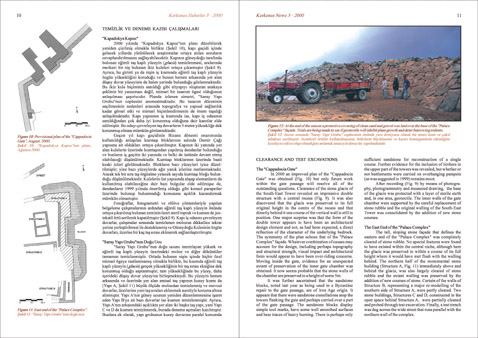|
CLEARANCE and TEST EXCAVATIONS
The "Cappadocia Gate
"
In 2000 an improved plan of the "Cappadocia Gate" was obtained
(Fig.
10) but only future work within the gate passage will resolve all
of the outstanding questions. Clearance of the stone glacis of the South-East
Tower revealed an impressive double structure with a central recess
(Fig 9a
9b
9c
9d
9e).
It was also discovered that the glacis was preserved to its full original
height in the centre of the recess and that directly behind it one course
of the vertical wall is still in position. One major surprise was that
the form of the double tower appears to have been an architectural design
element and not, as had been expected, a direct reflection of the character
of the underlying bedrock. The symmetry of the plan echoes that of the
"Palace Complex" fašade. Whatever combination of causes may
account for the design, including perhaps topography and structural
strength, visual impact and architectural form would appear to have
been over-riding concerns. Moving inside the gate, evidence for an unexpected
extent of preservation of the inner gate chamber was obtained. It now
seems probable that the stone walls of the chamber are preserved to
a height of some 5m.
It was further ascertained that the sandstone blocks, noted last year
as being used in a Byzantine repair to the gate passage, are of Iron
Age origin. It appears that there were sandstone crenellations atop
the towers flanking the gate and perhaps carried over a part of the
gate passage. The sandstone blocks display simple tool marks, have some
well smoothed surfaces and bear traces of heavy burning. There is perhaps
only sufficient sandstone for reconstruction of a single course. Further
evidence for the inclusion of timbers in the upper part of the towers
was revealed, but whether or not battlements were carried on overhanging
parapets (as was suggested in 1999) remains moot.
After recording (Fig 9a
9b
9c
9d
9e)
by means of photogra-phy, photogrammetry and measured drawing, the base
of the glacis was protected with a layer of sterile earth and, in one
area, geotextile. The inner walls of the gate chamber were supported
by the careful replacement of stone rubble and the original walling
of the South-East Tower was consolidated by the addition of new stone
courses.
The East End of the "Palace
Complex"
The tall, sloping stone fašade that defines the eastern end of the "Palace
Complex" was completely cleared of stone rubble. No special features
were found to have existed within the central niche, although here the
glacis was preserved to within a course of its full height where it
would have met flush with the walling behind. The northern half of the
monumental stone building (Structure A, Fig.
11) immediately above and behind the glacis, was also largely cleared
of stone rubble and the extant walling was preserved by the addition
of new courses of stone. Certain of the walls of Structure B, representing
a major re-modelling of the southern side of Structure A, were partly
cleared. Two stone buildings, Structures C and D, constructed in the
open space behind Structure A, were partially cleaned and probed through
test excavation. Finally, a test trench was dug across the wide street
that runs parallel with the northern wall of the complex
Figure
12: At the end of the season a protective covering of clean sand
and gravel was laid over the base of the "Palace Complex"
fašade. Trials are being made to see if geotextile will inhibit plant
growth and deter burrowing rodents. |



